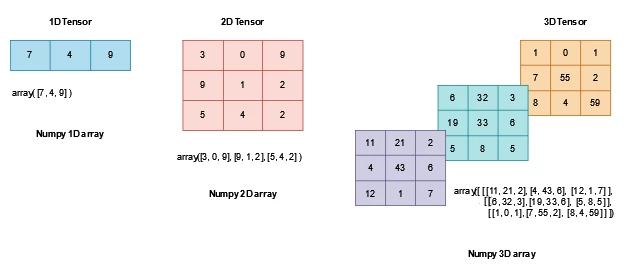张量(tensor)是一种类似于数组和矩阵的特殊数据结构。tensor类似于NumPy中的ndarray,两者也可以使用相同的内存地址。

创建Tensor
直接使用数据创建
1
2
3
4
5
|
import torch
import numpy as np
data = [[1, 2],[3, 4]]
x_data = torch.tensor(data)
|
使用NumPy array创建
1
2
3
4
5
6
7
8
9
10
|
np_array = np.array(data)
x_np = torch.from_numpy(np_array)
print(f"Numpy np_array value: \n {np_array} \n")
print(f"Tensor x_np value: \n {x_np} \n")
np.multiply(np_array, 2, out=np_array)
print(f"Numpy np_array after * 2 operation: \n {np_array} \n")
# x_np会和np_array一起改变
print(f"Tensor x_np value after modifying numpy array: \n {x_np} \n")
|
由于np_array和x_np使用相同的内存地址,两者的值会同时改变
使用其他tensor创建
tensor可以使用其他tensor的属性(包括tensor的shape,dtype)进行初始化
1
2
3
4
5
6
7
|
x_ones = torch.ones_like(x_data)
# x_ones会保持和x_data相同的属性,所有元素都为1
print(f"Ones Tensor: \n {x_ones} \n")
x_rand = torch.rand_like(x_data, dtype=torch.float)
# x_rand保持x_data的属性,dtype设为torch.float
print(f"Random Tensor: \n {x_rand} \n")
|
使用随机数或常数创建
1
2
3
4
5
6
7
8
|
shape = (2,3,)
rand_tensor = torch.rand(shape)
ones_tensor = torch.ones(shape)
zeros_tensor = torch.zeros(shape)
print(f"Random Tensor: \n {rand_tensor} \n")
print(f"Ones Tensor: \n {ones_tensor} \n")
print(f"Zeros Tensor: \n {zeros_tensor}")
|
Tensor的属性
1
2
3
4
5
|
tensor = torch.rand(3,4)
print(f"Shape of tensor: {tensor.shape}")
print(f"Datatype of tensor: {tensor.dtype}")
print(f"Device tensor is stored on: {tensor.device}")
|
tensor的属性包括维度shape,数据类型dtype,和存储的设备类型device
Tensor的操作
tensor的参考文档
tensor创建时默认处于CPU中,如果要使用GPU进行tensor计算需要使用.to设置
1
2
3
|
# 当GPU可用时,将tensor转移到GPU中
if torch.cuda.is_available():
tensor = tensor.to('cuda')
|
Tensor索引
1
2
3
4
5
6
|
tensor = torch.ones(4, 4)
print('First row: ',tensor[0])
print('First column: ', tensor[:, 0]) # 第一列
print('Last column:', tensor[..., -1]) # 最后一列
tensor[:,1] = 0 # 第二列元素置为0
print(tensor)
|
Tensor合并
tensor的合并有两种方法torch.cat和torch.stack
1
2
|
t1 = torch.cat([tensor, tensor, tensor], dim=1)
t1 = torch.stack([tensor, tensor, tensor], dim=1)
|
Tensor的数学运算
1
2
3
4
5
6
7
8
9
10
11
12
13
|
# 矩阵乘法
y1 = tensor @ tensor.T
y2 = tensor.matmul(tensor.T)
y3 = torch.rand_like(tensor)
torch.matmul(tensor, tensor.T, out=y3)
# 矩阵对应元素相乘
z1 = tensor * tensor
z2 = tensor.mul(tensor)
z3 = torch.rand_like(tensor)
torch.mul(tensor, tensor, out=z3)
|
单元素的tensor
单元素的tensor可以使用item()转变为Python中的数值量
1
2
3
|
agg = tensor.sum() # 将tensor中的元素相加
agg_item = agg.item() # 将单元素agg转为Python数值
print(agg_item, type(agg_item))
|
自动赋值运算
自动赋值运算通常在方法后有 _ 作为后缀,在运算中会直接改变运算量
1
2
3
|
print(tensor, "\n")
tensor.add_(5) # add_改变了tensor的元素值,每个元素加上5
print(tensor)
|
Tensor和NumPy
Tensor转为NumPy array
1
2
3
4
|
t = torch.ones(5)
print(f"t: {t}")
n = t.numpy()
print(f"n: {n}")
|
tensor和NumPy array共享内存,两者会同时改变
NumPy array转为Tensor
1
2
|
n = np.ones(5)
t = torch.from_numpy(n)
|

